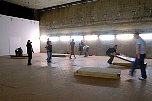


Hanging next to a concrete wall, beaten up and kicked by two guys in a fight and being set on fire - all in a day's work.
Though it was actually two days work.
And it wasn't work, but a fun way to spend a weekend.
The whole thing was a side effect of my 50th birthday earlier this year. As a present, I got a two day Action/Stunt-Weekend/Workshop. (One of those presents where you are never sure whether they want to do you a favor or whether they just want to see you get hurt. But I think it was meant to be a nice present. Which it turned out to be.)
I quite deliberately didn't look it up on the web, so I had no real idea what to expect.
And before I get started, I'd like to preface this with an apology about the dull pictures, but most stunts are aimed at looking good in motion. Driving around on top of a car is exciting, but on a photo it looks pretty much like just lounging around on a parked car. So only the fire stunts look reasonably impressive on still images. However, I supposedly will receive a DVD with some stuff from the workshop, so maybe I will be able to add some short video sequences later.
It turned out that the first thing to do was also the hardest one: Warm-up.
Not having done anything that resembles gymnastics since school days (and even back then, it was done with some reluctance), going through all the movement, stretching and other warm-up exercises was something I was not used to (though playing around with Wii-Fit did help). I still felt (and looked) quite odd when doing forward rolls, but once we got to shoulder rolls, I started to catch on.
First lesson of the day was 'hitting each other', introducing a couple of punches and kicking moves that look violent, but don't actually connect (much) and, if they do, not at the place they seem to be hitting.
Training was in pairs and since I was about the only one who was there together with a friend), I got the added advantage to train with Anja, a stuntwoman co-teaching the course, so I didn't have to worry about her hitting my by accident and could concentrate on my punches and reactions. And I got immediate feedback my 'moves', which was great!
After lunch, it was time to be set on fire.
Probably the best introduction to what stunt work is about. As Martin (primary teacher of the course) put it: "Stunts are not about doing crazy things. It's about making safe things look spectacular." (Though having a rather pragmatic definition of 'safe' might help as well.)
There's a huge effort made to keep the stunt as safe as possible (especially since non-professionals are involved). You wear a huge suit made from glass fiber; two fire-retardant baklavas cover the head, followed by a glass fiber hood.
And then you don a glass fiber cape (held by hand) and finally a piece of cloth is attached to that cape. And this is doused with gasoline (or something similar) and ignited.
And off you go.
And you really should. Because the flames on your back are about 800-1000 degrees, so if you walk to slow and the flames wrap around the head - that's not good.
Once you reach the destination mark, you just let go of the cape.
Then you walk a few more steps and lie down on the ground (in case that bits of you are still on fire) and get covered with a wet blanket until you get the ok sign and try to get out of your suit so the next one can have a go. (And it's 'one size, fits all', though sometimes it's a bit oversized.)
This looks quite impressive from the outside (at least the first couple of times - after that you see people just sitting around and chatting while other people run burning past them - everything gets mundane after a while), but while you're in the suit, you don't even notice that you're on fire. No sense of warmth or flickering flames on the side. The point where I realized that I really had been on fire was when I dropped the cape and it made a satisfying 'whoosh' sound.
And that's the point: It is not about having an exciting experience while walking around in flames; it's about walking around in relative comfort and looking good. (Though, re-reading the previous sentence, it sounds more like a quote about fashion than about stunts.)
(Interestingly, nobody reacts to such oddities. It was the first time that the stunt workshop took place at that site (a former factory building) and some parts of that area are used by other companies. So while we were doing the fire stunt, a minivan came by to drive to some other part of the area. So someone stopped the van, the person wearing the suit was set on fire and crossed the driveway, and the minivan could continue. Having a burning man cross the street in front of the van caused about as much a reaction as if we had carried some furniture across...)
After the fire, it was time to get back inside and do some stick fighting.
Probably the only really dangerous thing I did all day, since the sticks were solid and a bad move could break somebody's fingers. (The ends of the sticks were padded, but the sticks were hit wood-on-wood.)
But we had a well defined sequence of moves (improvising is a really bad idea here) and since there was the chance of some damage (quite evident by having someone break a stick during practice), everyone was alert and paying attention, so it all went well.
And when both sides had the rhythm fairly pat, it looked quite good.
Finally, everyone gets to step up in the middle of the room and show the short fight sequence and the first day is done.
The next morning starts with warm-up and stretching again, which is a bit harder to do than on the first day, since muscles are already a bit sore, but knowing what to expect, it's not that bad.
Then some more fighting.
We get shown a couple more 'moves' to practice. The moves were a bit more showy than the one from the previous day. While the those would fit a normal TV fight, the new moves look more like wrestling or Bud Spencer type moves - a bit implausible a bit over the top, and flashy.
We then get the task to work out a 'choreography' of a short fight on our own, taking into consideration lines of sight and camera position.
Since the number of people was odd, I was part of a group of three, so I got the chance of being beaten up by two other guys - just to make it seem less nasty, at least I got to be the 'aggressor' and throw the first punch. Fun way to spend a morning...
Next lesson was 'abseiling'. For that it was a bit of a disadvantage of being an 'early adopter'. There is a large silo on the premises, about 100 feet high, which will be used for abseiling, but since we were the first group on the new premises and the necessary attachment points were not in place yet. So we didn't do abseiling from the silo, but only indoor abseiling from one floor to the floor below, which is a bit less spectacular. (On the upside, though, we did have multiple runs, so we could do various kinds of abseiling and got to learn the difference between moving down a wall and moving down from a helicopter.
And the disadvantage of not being able to go down the silo was (hopefully) only temporary - we got the offer that we can visit one of next year's courses and do the abseiling only. So there's a chance that I will abseil the silo after all.
And then we were already at the last lesson of the course - the car stunt. A bit like a 'one person rollercoaster ride'. You get to lie on the roof of the car and try not to fall off. (Yes, there's a harness and attachment points to ensure that you don't really fall off, but that's just a safety device, you try to stay on top of the car by holding on with hands and feet only.)
A fun thing to do and suddenly going around a corner at 30 km/h seems quite fast. The main lesson is that you can stay on the car (if the windows are open and you can get a good grip) through almost everything at 30 km/h, including hard braking, going slalom and doing handbrake assisted turns, but at 50 km/h you can just hold on during normal driving maneuvers and any serious attempt to shake you off is quite likely to succeed.
Not a bit of knowledge that is likely to come in handy sometimes, though...
After all the talk of stunt needing to be safe, it was also interesting to see how much real stunt people follow that rule.
They needed some 'car driving' shots for insertion on the DVD, so Anja went into the car trunk to do a couple of 'below the car' and 'beside the car' video sequences from there - without helmet, safety harness or even some way to keep the trunk door from shutting down on her.
But then, she is a professional..
After that, the only thing left was a bit of sitting around, talking and drinking and listening to stories about the stunt business.
Which was a nice touch to not just have the weekend end abruptly, but let it sort of close on a quiet and relaxed note.
At the end there was also a certificate, which is in fact a bit of a disadvantage.
Seriously.
There are a lot of fun activities where you get some sort of certificate at the end, which is usually just for fun and basically just something to remember the event by, but without any real significance. This one, however, carries a bit of risk.
On one hand, I can now call myself a "certified stuntman" (which doesn't mean anything - it's not a protected phrase, so I could have called me that any time I liked). But if I actually do something stunt related, I now do it at my own risk.
Basically, if you do any guided activity, you can, if you get hurt, attempt to sue the guide for not making the activity 'safe' enough. That probably won't help you (and usually it won't hold up in court), but is an annoyance for the company offering the activity.
But if you are, for example, a high wire artist, the legal assumption is that you need to be aware what you are doing and that everything about that is your own responsibility. So if someone forgets to attach the high wire properly, legally, you can't blame anyone for that, since you should have checked before you stepped on that. (It's slightly different if someone intentionally sabotages something, but you can't hold anyone else responsible for negligence.)
And the same is true for stunt work - if you jump of a roof into an air bag, it's your responsibility alone - if you are a stuntman, who is assumed to know what he is doing.
So after completing the 'basic course', from a legal point of view, I am supposed to know what I am doing and hence I'm responsible for anything that might happen to me as a result. But then, I'm not likely to ever go to the advance course, since this is mainly for people who are quite serious of doing stunt work as a real job and there's also stuff that might seriously hurt you.
But doing the basic course was a lot of fun and I got to do some things that you rarely get to do otherwise - how many chances are there to walk around while being on fire and live to tell about it?